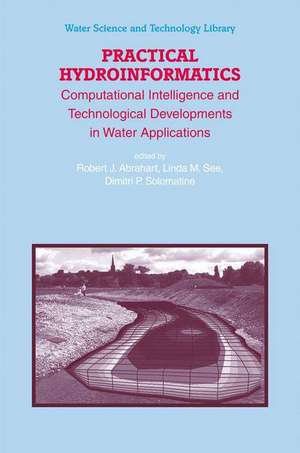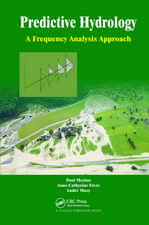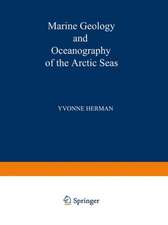Practical Hydroinformatics: Computational Intelligence and Technological Developments in Water Applications: Water Science and Technology Library, cartea 68
Editat de Robert J. Abrahart, Linda M. See, Dimitri P. Solomatineen Limba Engleză Hardback – 4 noi 2008
| Toate formatele și edițiile | Preț | Express |
|---|---|---|
| Paperback (1) | 802.74 lei 38-44 zile | |
| Springer Berlin, Heidelberg – 22 noi 2010 | 802.74 lei 38-44 zile | |
| Hardback (1) | 964.71 lei 6-8 săpt. | |
| Springer Berlin, Heidelberg – 4 noi 2008 | 964.71 lei 6-8 săpt. |
Din seria Water Science and Technology Library
- 18%
 Preț: 950.96 lei
Preț: 950.96 lei - 15%
 Preț: 646.62 lei
Preț: 646.62 lei - 24%
 Preț: 796.90 lei
Preț: 796.90 lei - 19%
 Preț: 546.76 lei
Preț: 546.76 lei - 18%
 Preț: 953.65 lei
Preț: 953.65 lei -
 Preț: 459.43 lei
Preț: 459.43 lei - 18%
 Preț: 742.31 lei
Preț: 742.31 lei - 18%
 Preț: 1226.11 lei
Preț: 1226.11 lei - 18%
 Preț: 956.50 lei
Preț: 956.50 lei - 18%
 Preț: 1225.48 lei
Preț: 1225.48 lei - 18%
 Preț: 776.40 lei
Preț: 776.40 lei - 18%
 Preț: 1014.76 lei
Preț: 1014.76 lei - 18%
 Preț: 957.13 lei
Preț: 957.13 lei - 24%
 Preț: 744.68 lei
Preț: 744.68 lei - 18%
 Preț: 953.35 lei
Preț: 953.35 lei - 18%
 Preț: 1108.04 lei
Preț: 1108.04 lei - 18%
 Preț: 1121.65 lei
Preț: 1121.65 lei - 15%
 Preț: 644.63 lei
Preț: 644.63 lei - 18%
 Preț: 1116.71 lei
Preț: 1116.71 lei - 18%
 Preț: 731.91 lei
Preț: 731.91 lei - 24%
 Preț: 744.31 lei
Preț: 744.31 lei - 18%
 Preț: 894.46 lei
Preț: 894.46 lei - 18%
 Preț: 1020.74 lei
Preț: 1020.74 lei - 24%
 Preț: 945.40 lei
Preț: 945.40 lei -
 Preț: 553.51 lei
Preț: 553.51 lei - 18%
 Preț: 1009.08 lei
Preț: 1009.08 lei
Preț: 964.71 lei
Preț vechi: 1176.47 lei
-18% Nou
Puncte Express: 1447
Preț estimativ în valută:
184.59€ • 192.73$ • 152.78£
184.59€ • 192.73$ • 152.78£
Carte tipărită la comandă
Livrare economică 05-19 aprilie
Preluare comenzi: 021 569.72.76
Specificații
ISBN-13: 9783540798804
ISBN-10: 3540798803
Pagini: 616
Ilustrații: XVI, 506 p. 243 illus., 5 illus. in color.
Dimensiuni: 155 x 235 x 35 mm
Greutate: 1 kg
Ediția:2008
Editura: Springer Berlin, Heidelberg
Colecția Springer
Seria Water Science and Technology Library
Locul publicării:Berlin, Heidelberg, Germany
ISBN-10: 3540798803
Pagini: 616
Ilustrații: XVI, 506 p. 243 illus., 5 illus. in color.
Dimensiuni: 155 x 235 x 35 mm
Greutate: 1 kg
Ediția:2008
Editura: Springer Berlin, Heidelberg
Colecția Springer
Seria Water Science and Technology Library
Locul publicării:Berlin, Heidelberg, Germany
Public țintă
ResearchCuprins
Hydroinformatics: Integrating Data and Models.- Some Future Prospects in Hydroinformatics.- Data-Driven Modelling: Concepts, Approaches and Experiences.- Artificial Neural Network Models.- Neural Network Hydroinformatics: Maintaining Scientific Rigour.- Neural Network Solutions to Flood Estimation at Ungauged Sites.- Rainfall-Runoff Modelling: Integrating Available Data and Modern Techniques.- Dynamic Neural Networks for Nonstationary Hydrological Time Series Modeling.- Visualisation of Hidden Neuron Behaviour in a Neural Network Rainfall-Runoff Model.- Correction of Timing Errors of Artificial Neural Network Rainfall-Runoff Models.- Data-Driven Streamflow Simulation: The Influence of Exogenous Variables and Temporal Resolution.- Groundwater Table Estimation Using MODFLOW and Artificial Neural Networks.- Neural Network Estimation of Suspended Sediment: Potential Pitfalls and Future Directions.- Models Based on Fuzzy Logic.- Fuzzy Logic-Based Approaches in Water Resource System Modelling.- Fuzzy Rule-Based Flood Forecasting.- Development of Rainfall–Runoff Models Using Mamdani-Type Fuzzy Inference Systems.- Using an Adaptive Neuro-fuzzy Inference System in the Development of a Real-Time Expert System for Flood Forecasting.- Building Decision Support Systems based on Fuzzy Inference.- Global and Evolutionary Optimization.- Global and Evolutionary Optimization for Water Management Problems.- Conditional Estimation of Distributed Hydraulic Conductivity in Groundwater Inverse Modeling: Indicator-Generalized Parameterization and Natural Neighbors.- Fitting Hydrological Models on Multiple Responses Using the Multiobjective Evolutionary Annealing-Simplex Approach.- Evolutionary-based Meta-modelling: The Relevance of Using Approximate Models in Hydroinformatics.- Hydrologic Model Calibration Using Evolutionary Optimisation.- Randomised Search Optimisation Algorithms and Their Application in the Rehabilitation of Urban Drainage Systems.- Neural Network Hydrological Modelling:An Evolutionary Approach.- Emerging Technologies.- Combining Machine Learning and Domain Knowledge in Modular Modelling.- Precipitation Interception Modelling Using Machine Learning Methods – The Dragonja River Basin Case Study.- Real-Time Flood Stage Forecasting Using Support Vector Regression.- Learning Bayesian Networks from Deterministic Rainfall–Runoff Models and Monte Carlo Simulation.- Toward Bridging the Gap Between Data-Driven and Mechanistic Models: Cluster-Based Neural Networks for Hydrologic Processes.- Applications of Soft Computing to Environmental Hydroinformatics with Emphasis on Ecohydraulics Modelling.- Data-Driven Models for Projecting Ocean Temperature Profile from Sea Surface Temperature.- Model Integration.- Uncertainty Propagation in Ensemble Rainfall Prediction Systems used for Operational Real-Time Flood Forecasting.- OpenMI – Real Progress Towards Integrated Modelling.- Hydroinformatics – The Challenge for Curriculum and Research, and the “Social Calibration”of Models.- A New Systems Approach to Flood Management in the Yangtze River, China.- Open Model Integration in Flood Forecasting.
Textul de pe ultima copertă
Hydroinformatics is an emerging subject that is expected to gather speed, momentum and critical mass throughout the forthcoming decades of the 21st century. This book provides a broad account of numerous advances in that field - a rapidly developing discipline covering the application of information and communication technologies, modelling and computational intelligence in aquatic environments. A systematic survey, classified according to the methods used (neural networks, fuzzy logic and evolutionary optimization, in particular) is offered, together with illustrated practical applications for solving various water-related issues. These include, but are not limited to, flood estimation, rainfall-runoff modelling, rehabilitation of urban water networks, estimation of ocean temperature profiles, etc. Particular attention is also given to certain aspects of the most recent technological progress in hydroinformatics including the development of protocols for model integration and of computer architectures for modern modelling systems. Invited contributions were obtained from leading international experts - including academics, hydrological practitioners and industrial professionals - such that this edited volume constitutes an authoritative source of reference material and is essential reading for active workers in this field.
Caracteristici
Includes supplementary material: sn.pub/extras







